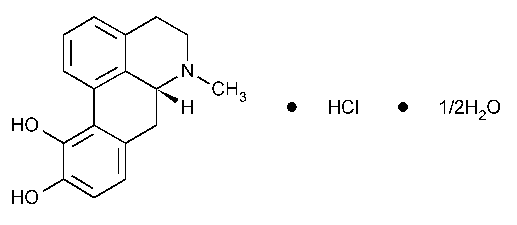Apomorphine Hydrochloride
4H-Dibenzo[de,g]quinoline-10,11-diol,5,6,6a,7-tetrahydro-6-methyl-,hydrochloride,hemihydrate,(R)-.
6ab-Aporphine-10,11-diol hydrochloride hemihydrate [41372-20-7].
Anhydrous 303.79 [314-19-2].
»Apomorphine Hydrochloride contains not less than 98.5percent and not more than 100.5percent of C17H17NO2·HCl,calculated on the dried basis.
Packaging and storage—
Preserve in small,tight,light-resistant containers.Containers from which Apomorphine Hydrochloride is to be taken for immediate use in compounding prescriptions contain not more than 350mg.
Color of solution—
Place 100mg in a suitable test tube,add 10mLof cold,oxygen-free water,and agitate gently until dissolved:the color of the resulting solution,observed promptly after the Apomorphine Hydrochloride has dissolved,is not more intense than that of a color standard prepared as follows.Dissolve 5mg of Apomorphine Hydrochloride in 100.0mLof water.Transfer 1.0mLof this solution to a test tube of the same size as that used for the test solution,dilute with 6mLof water,add 1mLof sodium bicarbonate solution (1in 20),and then add 0.50mLof iodine TS.Allow to stand for 30seconds,add 0.60mLof sodium thiosulfate solution (1in 40),and dilute with water to 10mL.
Identification—
A:
Infrared Absorption á197Kñ.
B:
To 5mLof a solution (1in 100)add a slight excess of sodium bicarbonate solution (1in 20):a white or greenish-white precipitate is formed.Add 3drops of iodine TS,and shake vigorously:an emerald-green color is produced.Add 5mLof ether and,after vigorous shaking,allow the layers to separate:the ether is colored deep ruby-red while the water layer retains its green color.
C:
Dissolve it in nitric acid:a dark purple solution is produced.
D:
To a solution of it add silver nitrate TS:a white precipitate,which is insoluble in nitric acid,is formed.This precipitat e soon darkens by reduction to metallic silver,the reduction being accelerated by the addition of 6Nammonium hydroxide.
Specific rotation á781Sñ:
between -60.5 and -63.0
and -63.0 .
.
Test solution:
15mg per mL,in dimethylsulfoxide.
Loss on drying á731ñ—
Dry it at 105 for 2hours:it loses between 2.0%and 3.5%of its weight.
for 2hours:it loses between 2.0%and 3.5%of its weight.
Residue on ignition á281ñ:
not more than 0.1%.
Decomposition products—
Shake 100mg with 5mLof ether:the latter acquires not more than a pale reddish color.
Ordinary impurities á466ñ—
Solvent for Test Solution:
methanol.
Solvent for Standard Solution:
methanol.
Eluant:
a mixture of 1-butanol,water,and formic acid (7:2:1).
Visualization:
a freshly prepared mixture of 10%ferric chloride solution and 5%potassium ferricyanide solution (2:1).Allow the chromatograms to develop until the solvent front has moved about 8cm.[NOTE—The development time is 1.5to 2hours.]Allow the plates to dry at room temperature for 1hour prior to spraying.
Assay—
Dissolve about 300mg of Apomorphine Hydrochloride,accurately weighed,in 100mLof glacial acetic acid with the aid of heat provided by a steam bath.Add 0.1mLof acetic anhydride to the hot solution,and stir for 5minutes.Cool to room temperature,add 5mLof mercuric acetate TSand 0.25mLof crystal violet TS,and titrate with 0.1Nperchloric acid VSto a blue endpoint.Perform a blank determination,and make any necessary correction.Each mLof 0.1Nperchloric acid is equivalent to 30.38mg of C17H17NO2·HCl.
Auxiliary Information—
Staff Liaison:Elena Gonikberg,Ph.D.,Scientist
Expert Committee:(PA4)Pharmaceutical Analysis 4
USP28–NF23Page 173
Phone Number:1-301-816-8251
